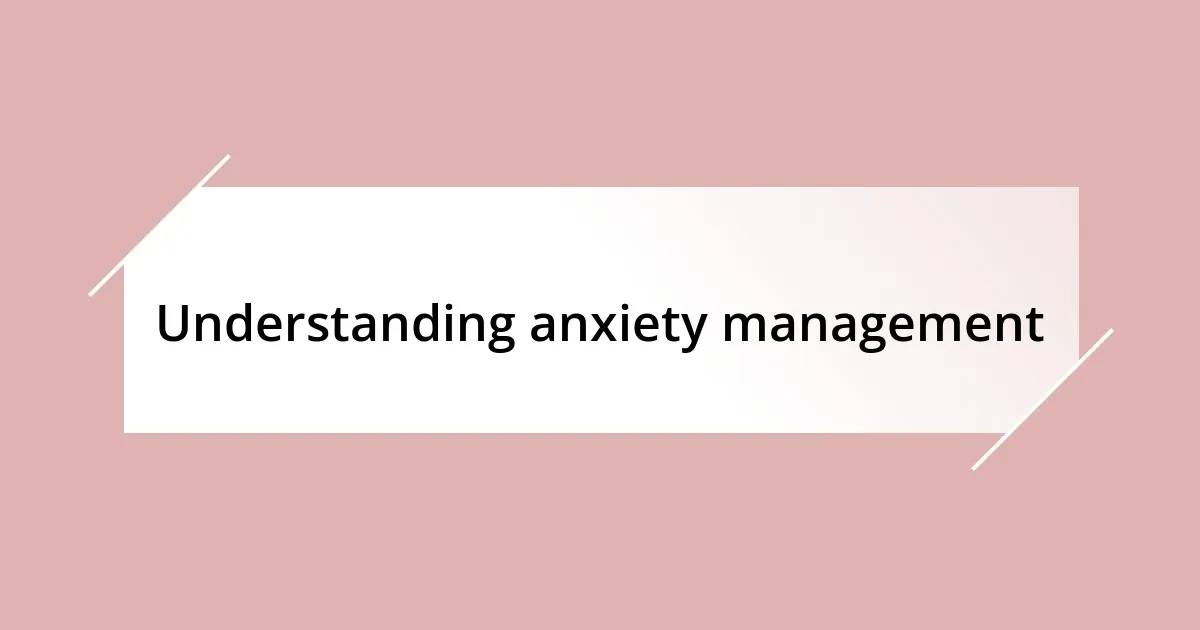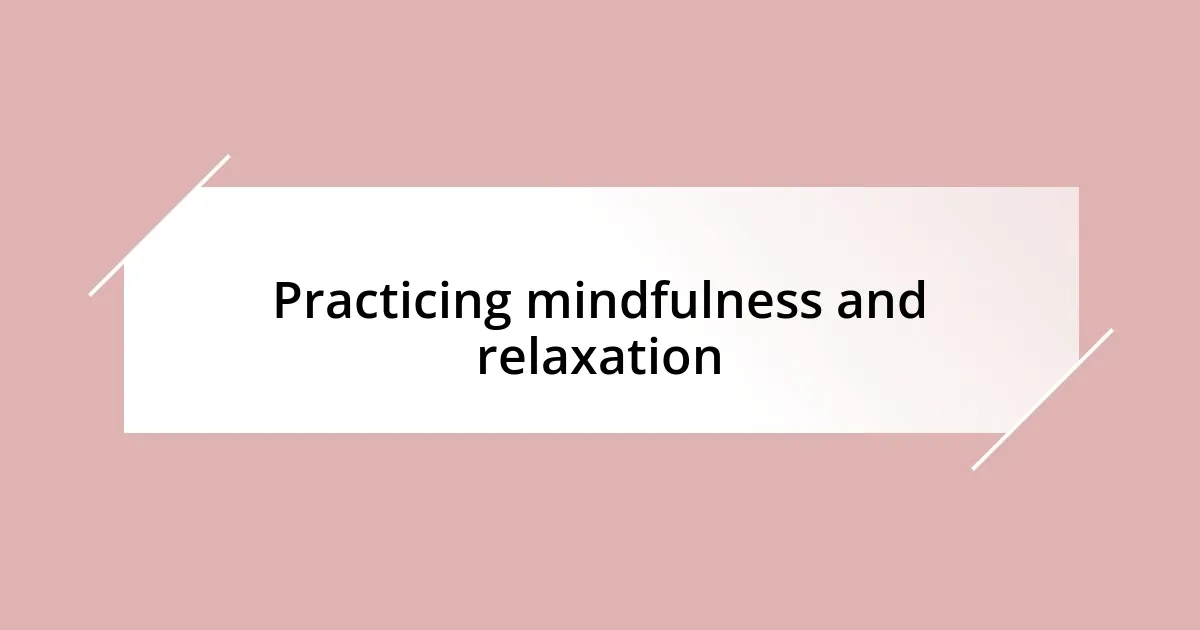Key takeaways:
- Anxiety management is a personal journey that involves understanding triggers and adapting coping strategies based on individual experiences.
- Mindfulness practices, including deep breathing and progressive muscle relaxation, are effective techniques for regaining control over anxiety.
- Establishing a support network provides emotional validation and practical advice, helping individuals feel less isolated in their struggles.
- Regular evaluation and adjustment of techniques are crucial for long-term success in managing anxiety, encouraging exploration of new strategies.

Understanding anxiety management
Anxiety management isn’t a one-size-fits-all solution; it’s a highly personal journey. I remember the first time I faced a significant wave of anxiety. My heart raced, my palms were sweaty, and I struggled to catch my breath—all classic symptoms. It was then I realized that understanding my triggers was just as crucial as seeking relief.
For me, mindfulness made a remarkable difference. Halting in the midst of chaos to focus on my breath felt like I was reclaiming control. Have you ever noticed how just a few deep breaths can sometimes shift your perspective? In those moments, I felt empowered, even if just for a brief second, to push back against the tide of anxiety.
It’s also important to acknowledge that some days are more manageable than others. The ebbs and flows can be frustrating, but I’ve learned to adapt. How do you handle those tough days? I often reflect on what techniques worked well before, allowing me to discover new coping strategies that resonate with my evolving needs.

Identifying triggers and symptoms
Recognizing my anxiety triggers has been a game changer in managing my symptoms. For instance, I’ve observed that crowded places often heighten my anxiety levels. Just last week, I found myself feeling agitated in a bustling café; it was a vivid reminder of how environments can affect our mental state.
Symptoms of anxiety can manifest in various ways, from physical sensations like tightness in the chest to racing thoughts that cloud reason. I remember one particular day when the anticipation of a big meeting left me feeling dizzy and detached; it was as if the very air around me shifted. These experiences taught me that knowing how my body reacts can empower me to take proactive steps—like engaging in grounding techniques that re-center my focus.
It’s fascinating how awareness of these elements, triggers, and symptoms is the first step toward management. I often keep a journal to note down situations that exacerbate my anxiety and how I felt in those moments. This practice not only illuminates patterns but also offers me clarity on what strategies might work best in future encounters.
| Triggers | Symptoms |
|---|---|
| Crowded places | Increased heart rate, sweating |
| Public speaking | Racing thoughts, dizziness |

Developing effective coping strategies
Developing effective coping strategies requires a personal touch, as what works for one individual may not suit another. I found that creating a toolkit of diverse techniques allowed me to respond flexibly to my anxiety when it strikes. When I sensed the familiar pang of anxiety creeping in, I could reach for the most suitable tool, whether it’s taking a short walk or listening to my favorite calming playlist.
Here are some strategies that have made a real difference for me:
- Deep breathing exercises: I often take a moment to focus on inhaling deeply for a count of four, holding it for four, and then exhaling slowly—this brings me back to a state of calm.
- Physical movement: A quick jog or even a few stretches can shake off the tension; I remember one stressful afternoon when a brisk walk in the park cleared my head and lifted my spirit.
- Journaling: Writing about my thoughts helps me process my experiences and gain insight into patterns, making the anxiety feel a little less daunting.
- Connection with nature: Stepping outside, even briefly, can ground me—there’s something soothing about connecting with the environment around me.
- Mindfulness meditation: Engaging in a short meditation session allows me to regain focus and clarity. I once experienced a moment of tranquility that transcended my anxiety, reminding me that peace is just a breath away.
Through trial and error, I’ve learned that flexibility in coping strategies is essential. I’ve found solace in adapting my approach based on how I’m feeling. It’s comforting to know that there are various avenues to explore, each offering a unique path to managing anxiety while fostering a deeper understanding of my inner landscape.

Practicing mindfulness and relaxation
Practicing mindfulness has become a cornerstone of my anxiety management. I often find a quiet corner in my home, close my eyes, and focus on my breath. Just yesterday, after a stressful day, I dedicated ten minutes to this practice and noticed how my racing thoughts began to slow, almost like watching a frenzied river calm into a serene pond. Isn’t it fascinating how a few minutes of stillness can reset our minds?
In addition to breathwork, I’ve incorporated progressive muscle relaxation into my routine. I remember a particularly overwhelming week when I felt tension creeping into every muscle. Taking the time to consciously tense and then release each muscle group helped me feel liberated, like shedding a heavy coat. It’s amazing how our bodies hold onto stress, and setting aside even five minutes for this practice can make a world of difference.
Mindfulness isn’t just limited to taking breaths or relaxing muscles. I’ve started practicing mindful walking, which has turned into a joyful revelation. When I walk, I focus on the sensation of my feet touching the ground and the rhythm of my steps. On one of those walks, I noticed the vibrant colors of the leaves changing; it sparked a sense of gratitude that lifted my mood. Have you ever paused to truly absorb your surroundings? It’s in these moments that I find clarity, and my anxiety begins to dissolve.

Establishing a support network
Establishing a support network has been a game changer in my battle with anxiety. I remember feeling isolated during some of my toughest moments, struggling to articulate what I was experiencing. When I finally reached out to a friend who understood my situation, it was like lifting a heavy weight off my shoulders. Have you ever shared your thoughts with someone who truly gets it? It’s remarkable how just knowing you’re not alone can lighten the load.
It’s essential to surround myself with people who can provide both emotional support and practical advice. One time, a close friend and I scheduled regular catch-up calls, where we would both talk about our struggles and triumphs. This regular check-in became a lifeline for me, reminding me that we were in this together. The feeling of being heard and validated made a profound difference in how I coped with anxiety. Don’t you think having someone to lean on makes the journey feel less daunting?
Finding the right support network also means being open to new connections. I started attending a local anxiety support group, where I met people who shared similar experiences. There was one evening where we all shared our strategies and stories; I left with a renewed sense of hope and a list of new coping techniques to try. The camaraderie and understanding were palpable, revealing the strength we all possess when we come together. Isn’t it wonderful how community can foster resilience? Building a support system that resonates with your experiences can be incredibly empowering.

Evaluating progress and adjustments
Evaluating progress in managing anxiety requires a careful look at what’s been working and what hasn’t. I recall a period when my anxiety seemed to spike despite my efforts with meditation and journaling. It made me pause and reflect: was I truly giving these strategies enough time to take effect? I realized that tracking my responses to these practices, perhaps through a simple journal, helped me gauge their effectiveness over time.
Adjustments are just as crucial as evaluation. One day, I noticed my evening routine—a mix of reading and screen time—wasn’t bringing me calm as it once did. I decided to swap out half an hour of television for some gentle yoga instead. The shift was subtle yet powerful. It taught me that the path to managing anxiety isn’t always about sticking with what you know; sometimes, it’s about experimenting until you find a better fit.
I often ask myself, “How can I improve this process?” This curiosity drives me to tweak my approaches regularly. For example, I tried integrating shorter mindfulness sessions throughout my day rather than just dedicating a block of time in the evening. This small change made a big difference, reminding me that progress doesn’t always have to be a monumental shift; it can simply be finding joy in the adjustments we make along the way.

Maintaining long-term anxiety management
Maintaining long-term anxiety management calls for a consistent and flexible approach. I remember a time when I found myself relying too heavily on one technique, thinking it was my cure-all. After a few months, I noticed diminishing returns, which led me to question, “Was I keeping my strategies fresh?” That’s when I began to mix things up, incorporating new activities like nature walks and creative hobbies. It felt invigorating to discover what else worked for me. Don’t you find that exploring different avenues can breath life back into your routines?
Another key aspect is regular self-reflection. I’ve made it a habit to carve out a little time each week to check in with myself. Asking questions like, “How did I handle stress this week?” or “What made me anxious?” gives me insight into my emotional landscape. It’s a powerful practice; I often come away with new realizations about triggers I hadn’t noticed before. Why is it that we sometimes overlook our own feelings? This simple act of reflection has allowed me to tailor my anxiety management strategies more effectively.
Lastly, celebrating small victories plays a vital role in my journey. I recall feeling a rush of joy when I realized I’d gone a week without my usual overwhelming anxiety. Acknowledging those moments, no matter how small, reinforces progress and commitment. How do you recognize your wins? Keeping a victory journal has been an excellent way for me to see my progress over time. I encourage you to pause and appreciate your own strides forward, as recognizing success can motivate you to keep going.












